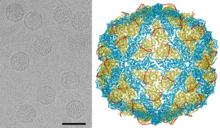Alphachrysovirus is a genus of double-stranded RNA viruses. It is one of two genera in the family Chrysoviridae.[2] They infect fungi, in particular Penicillium. Their name is derived from the Greek word chrysos which means yellow-green. There are 20 species in this genus.[1][3][4]
| Alphachrysovirus | |
|---|---|

| |
| Cryo-EM reconstruction of penicillium chrysogenum virus (PcV) virions[1] | |
| Virus classification | |
| (unranked): | Virus |
| Realm: | Riboviria |
| Kingdom: | Orthornavirae |
| Phylum: | Duplornaviricota |
| Class: | Chrymotiviricetes |
| Order: | Ghabrivirales |
| Family: | Chrysoviridae |
| Genus: | Alphachrysovirus |
Structure
editViruses in the genus Alphachrysovirus are non-enveloped, with icosahedral geometries, and T=1, T=2 symmetry. The diameter is around 35–40 nm.[1][3]
Genome
editGenomes are linear double-stranded RNA which is around 12.5 kbp in length. The genome codes for four proteins. The genome has three double stranded RNA segments. All have extended highly conserved terminal sequences at both ends.[1][3]
Life cycle
editViral replication is cytoplasmic. Entry into the host cell is achieved by penetration into the host cell. Replication follows the double-stranded RNA virus replication model. Double-stranded RNA virus transcription is the method of transcription. The virus exits the host cell by cell to cell movement. Fungi serve as the natural host.[1][3]
| Genus | Host details | Tissue tropism | Entry details | Release details | Replication site | Assembly site | Transmission |
|---|---|---|---|---|---|---|---|
| Alphachrysovirus | Fungi | None | Cytoplasmic exchange; sporogenesis; Hyphal anastomosis | Cytoplasmic exchange; sporogenesis; Hyphal anastomosis | Cytoplasm | Cytoplasm | Cytoplasmic exchange; sporogenesis; Hyphal anastomosis |
Taxonomy
editThe following species are recognized:[4]
- Amasya cherry disease associated chrysovirus
- Anthurium mosaic-associated chrysovirus
- Aspergillus fumigatus chrysovirus
- Brassica campestris chrysovirus
- Chrysothrix chrysovirus 1
- Colletotrichum gloeosporioides chrysovirus
- Cryphonectria nitschkei chrysovirus 1
- Fusarium oxysporum chrysovirus 1
- Helminthosporium victoriae virus 145S
- Isaria javanica chrysovirus
- Macrophomina phaseolina chrysovirus
- Penicillium brevicompactum virus
- Penicillium chrysogenum virus
- Penicillium cyaneofulvum virus
- Persea americana chrysovirus
- Raphanus sativus chrysovirus
- Salado alphachrysovirus
- Shuangao insect-associated chrysovirus
- Verticillium dahliae chrysovirus 1
- Zea mays chrysovirus 1
References
edit- ^ a b c d e f g "ICTV Report Chrysoviridae".
- ^ Kotta-Loizou, I; Castón, JR; Coutts, RHA; Hillman, BI; Jiang, D; Kim, DH; Moriyama, H; Suzuki, N; ICTV Report Consortium (February 2020). "ICTV Virus Taxonomy Profile: Chrysoviridae". The Journal of General Virology. 101 (2): 143–144. doi:10.1099/jgv.0.001383. PMC 7414429. PMID 31958044.
- ^ a b c d "Viral Zone". ExPASy. Retrieved 15 June 2015.
- ^ a b "Virus Taxonomy: 2020 Release". International Committee on Taxonomy of Viruses (ICTV). March 2021. Retrieved 13 May 2021.